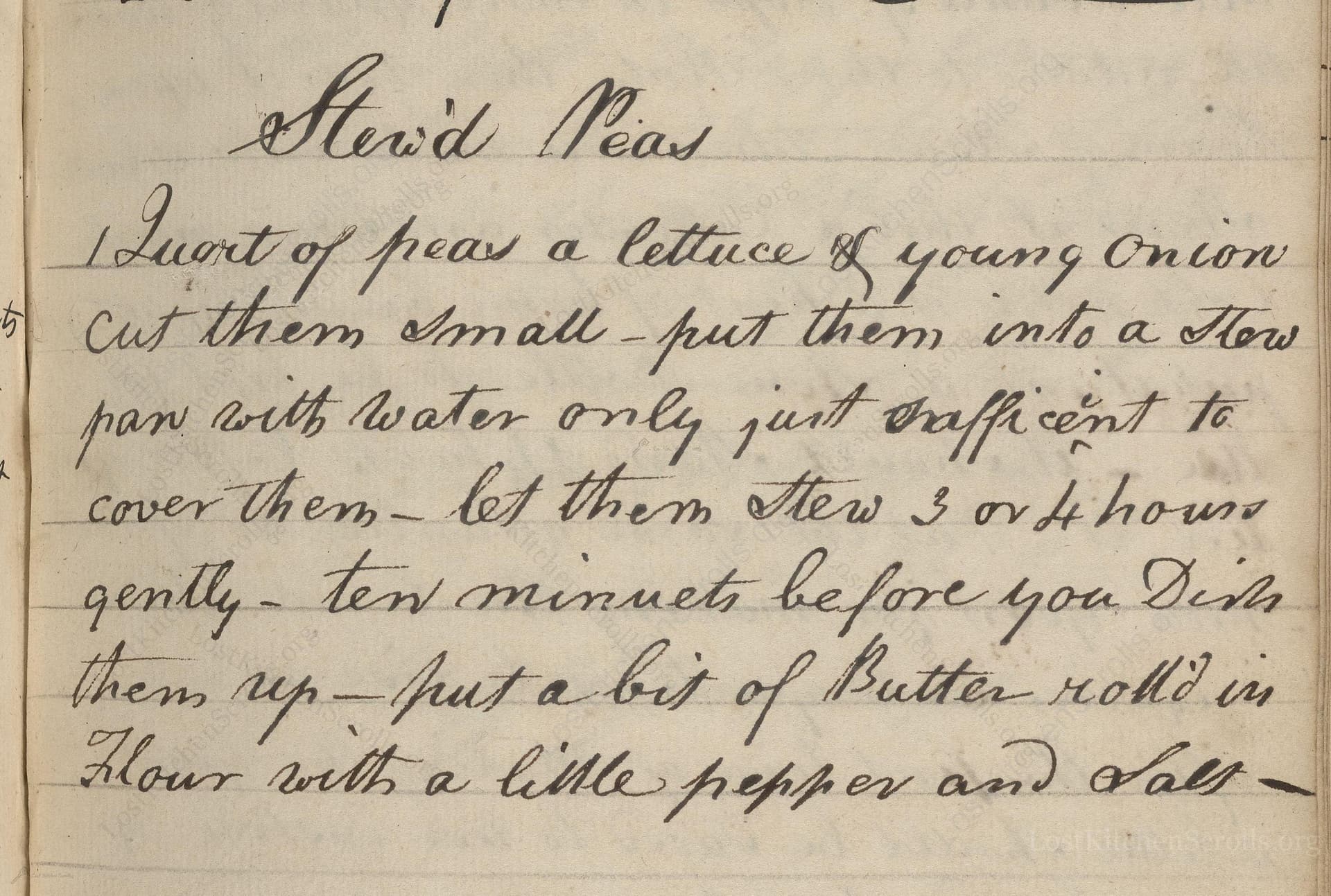Stew'D Peas
From the treasured pages of Cookbook of Elizabeth Langley
Written by Elizabeth Langley

Stew'D Peas
"1 Quart of peas a lettuce & young Onion cut them small - put them into a Stew pan with Water only just sufficient to cover them - let them Stew 3 or 4 hours gently - ten minuets before you Dish them up - put a bit of Butter roll'd in Flour with a little pepper and Salt -"
Note on the Original Text
The original recipe was written in a conversational, shorthand style without standardized measurements or precise instructions—typical for 18th-century English cookbooks, which assumed a certain level of skill and intuition from the reader. Spellings reflect the period, such as 'Stew'd' for 'stewed', and the directions were succinct, often omitting details considered obvious to contemporary cooks. Modern renditions require clarification of quantities and techniques, such as the use of butter rolled in flour (an early thickening method akin to beurre manié), and turning implicit knowledge into explicit steps for today's kitchens.

Title
Cookbook of Elizabeth Langley (1757)
You can also click the book image above to peruse the original tome
Writer
Elizabeth Langley
Era
1757
Publisher
Unknown
Background
Step into the Georgian kitchen with Elizabeth Langley's 1757 culinary collection, where refined techniques and delightful recipes await those with a taste for historic gastronomy.
Kindly made available by
Folger Shakespeare Library
This recipe hails from mid-18th century England, as documented in 1757 by Elizabeth Langley. Dishes like this reflected the period's emphasis on gentle, vegetable-forward cookery that showcased the freshness of early-summer produce. Peas, lettuce, and young onions were favored for their delicate flavors, while lengthy slow cooking was typical, partly due to the limitations of hearth and wood-fired cookery. Recipes like this would have been prepared as either a standalone meal in modest homes or a refined side dish in wealthier households, illustrating the versatility and appeal of simple garden ingredients in Georgian-era cuisine.

In the 18th century, this dish would have been prepared over an open hearth or in a kitchen fireplace, using a heavy stew pan or earthenware pot. A long-handled wooden spoon would have been used for stirring, and cooks relied on the gentle, sustained heat of burning wood or charcoal to simmer the peas slowly. Measuring was approximate, depending greatly on the cook's experience and eye.
Prep Time
10 mins
Cook Time
3 hrs
Servings
4
We've done our best to adapt this historical recipe for modern kitchens, but some details may still need refinement. We warmly welcome feedback from fellow cooks and culinary historians — your insights support the entire community!
Ingredients
- 4 cups fresh or frozen peas
- 1 head soft lettuce (e.g., butter lettuce)
- 3-4 small spring onions (scallions, about 2 ounces total)
- Water (just enough to cover vegetables, around 2 to 3 cups)
- 2 tablespoons (1 ounce) unsalted butter
- 1 tablespoon (1/2 ounce) plain flour
- Salt, to taste
- Freshly ground black pepper, to taste
Instructions
- To recreate 'Stew'd Peas' in a modern kitchen, start by gathering 4 cups of fresh or frozen peas, one head of tender lettuce, and a small bunch (three to four) of young spring onions.
- Finely chop the lettuce and onions, and combine them in a medium saucepan with the peas.
- Add just enough water to barely cover the vegetables.
- Bring the mixture to a gentle simmer, cover, and cook on low heat for 3 to 4 hours, checking occasionally to ensure it doesn't dry out.
- About 10 minutes before serving, stir in a generous knob (about 2 tablespoons or 1 ounce) of unsalted butter rolled in a tablespoon (about 1/2 ounce) of plain flour.
- Season with salt and freshly ground black pepper to taste.
- Continue cooking until the butter has melted and lightly thickened the juices.
- Serve warm as a comforting side dish or light supper.
Estimated Calories
160 per serving
Cooking Estimates
You will need about 10 minutes to prepare the vegetables. Cooking takes around 3 hours on low heat. Each serving contains about 160 calories. This recipe makes 4 servings.
As noted above, we have made our best effort to translate and adapt this historical recipe for modern kitchens, taking into account ingredients nowadays, cooking techniques, measurements, and so on. However, historical recipes often contain assumptions that require interpretation.
We'd love for anyone to help improve these adaptations. Community contributions are highly welcome. If you have suggestions, corrections, or cooking tips based on your experience with this recipe, please share them below.
Join the Discussion
Rate This Recipe
Dietary Preference
Main Ingredients
Culinary Technique
Occasions

Den Bockfisch In Einer Fleisch Suppen Zu Kochen
This recipe hails from a German manuscript cookbook compiled in 1696, a time whe...

Die Grieß Nudlen Zumachen
This recipe comes from a rather mysterious manuscript cookbook, penned anonymous...

Ein Boudain
This recipe comes from an anonymous German-language manuscript cookbook from 169...

Ein Gesaltzen Citroni
This recipe, dating from 1696, comes from an extensive anonymous German cookbook...
Browse our complete collection of time-honored recipes



